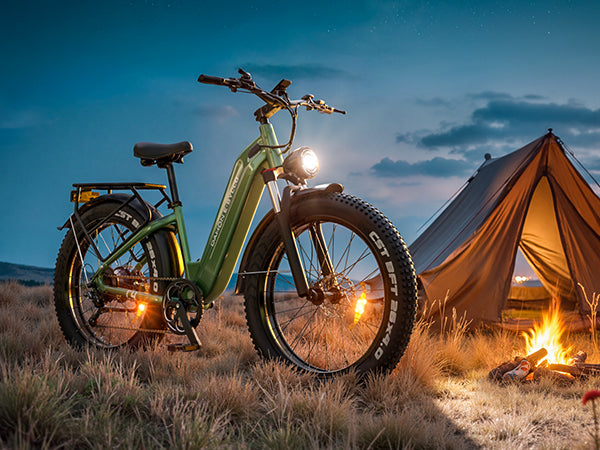Electric bike have gained widespread popularity as an eco-friendly, efficient, and fun mode of transportation. At the heart of every e-bike is its motor, which plays a crucial role in determining the bike’s power, speed, and overall performance. Understanding how these motors work and what to look for when choosing an e-bike motor can help you make a more informed decision when selecting your next bike.
Types of E-Bike Motors
E-bike motors generally fall into three main categories: hub motors, mid-drive motors, and rear-wheel motors. Each type has distinct characteristics that suit different riding styles and preferences.
1. Hub Motors:
Hub motors are the most common motor type found in electric bikes. As the name suggests, the motor is located in the hub of either the front or rear wheel. This setup offers a smooth, quiet ride with minimal maintenance, as the motor is self-contained within the wheel hub.

Advantages:
Simple Design: Hub motors are easy to maintain and replace.
Cost-Effective: Generally more affordable compared to mid-drive motors.
Quiet Operation: Hub motors are typically quieter than mid-drive motors.
Lower Maintenance: Since the motor is separate from the drivetrain, there’s less wear and tear on the chain and gears.
Disadvantages:
Less Efficient on Steep Hills: Hub motors provide less torque, which can make climbing steep inclines more challenging.
Heavier Weight Distribution: The motor’s weight is concentrated in the wheel, affecting the bike’s handling and balance.
2. Mid-Drive Motors:
Mid-drive motors are positioned at the center of the bike, typically near the pedal crankset. This type of motor offers more efficient power delivery and is often favored by serious cyclists and mountain bikers.

Advantages:
Better Torque and Climbing Ability: Mid-drive motors provide more torque, making them ideal for tackling steep hills and rough terrain.
Efficient Power Usage: The motor powers the bike through the bike’s gears, meaning it can take advantage of the bike’s gear ratios for improved efficiency and performance.
Better Weight Distribution: Mid-drive motors are centrally located, helping to improve balance and handling.
Disadvantages:
Higher Cost: Mid-drive motors are typically more expensive due to their advanced design and performance.
More Maintenance: Since the motor interacts with the drivetrain, it can cause more wear on the chain and other components, requiring more frequent maintenance.
3. Rear-Wheel Motors:
Rear-wheel motors are similar to hub motors but are specifically located in the rear wheel. These motors provide good power and balance, making them popular for city commuting and leisure biking.
Advantages:
Good for Commuting: Rear-wheel motors provide smooth power delivery for city commuting and casual rides.
Improved Traction: Since the motor is located at the rear wheel, it can provide better traction, especially when accelerating or climbing hills.
Disadvantages:
Less Efficient on Hills: Rear-wheel motors, like hub motors, are less powerful than mid-drive motors when it comes to tackling steep inclines.
Heavier Rear-End: The weight distribution of the motor in the rear wheel can affect handling, especially when carrying extra weight or cargo.
Motor Power and Speed
The power of an e-bike motor is typically measured in watts (W). The higher the wattage, the more powerful the motor, which usually translates to better performance, particularly when it comes to speed and hill climbing.
500W Motor: This is the most common motor size for casual commuters and those who ride on relatively flat terrain. It provides a smooth, moderate level of power for everyday use.
1000W Motor: A more powerful option that’s great for users who want faster speeds or who plan to ride on hilly terrain. It offers a good balance between power and energy efficiency.
2000W and Above: These motors are ideal for enthusiasts, mountain bikers, or those who want to achieve higher speeds and tackle rougher terrain. Motors in this range typically offer speeds up to 30-40 MPH and are great for off-road adventures.
Motor Efficiency and Battery Life
The efficiency of the motor is directly related to the bike’s battery life. Mid-drive motors tend to be more energy-efficient because they utilize the bike’s gears to maintain a more consistent power output, extending battery life. Hub motors, while less efficient in terms of power usage, are often paired with larger batteries that compensate for their energy consumption.
When selecting an e-bike, consider how far you plan to ride and whether you’ll be using the bike for commuting, recreation, or off-road adventures. If you prioritize long-range riding, choosing a motor with higher efficiency(1000W or above) can be more beneficial in the long run.
Choosing the Right Motor for Your Needs
When selecting the motor for your e-bike, there are several factors to consider:
Terrain: If you plan to ride on hilly or off-road terrain, a mid-drive motor with higher torque or a hub motor with higher power rating are both ideal choices.
Speed and Power: If you want higher speeds and more power for mountain biking or long-distance rides, consider motors in the 1000W+ range.
Maintenance: If you’re looking for a low-maintenance bike, a hub motor might be your best option.
Price: Hub motors tend to be less expensive, while mid-drive motors typically come with a higher price tag due to their advanced capabilities.
Conclusion
The motor of an electric bicycle is integral to the overall riding experience, affecting everything from speed and torque to efficiency and maintenance. Whether you’re commuting in the city, cruising through the countryside, or taking on challenging mountain trails, understanding the different types of motors and their respective benefits will help you make the right choice for your needs.
As electric bicycles continue to evolve, so do their motors. Advancements in technology are making e-bikes more powerful, efficient, and affordable, allowing riders to enjoy a more enjoyable and sustainable cycling experience.

